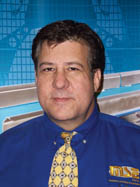
Unfortunately, most conveyors have more nooks and crannies than a pack rat's lair. In the meat and poultry business, washdown has become a costly, labor-intensive chore that may or may not result in a sanitary system for the next day's shift. For Tampa, FL-based Material Systems Engineering (MSE) Inc., the need for sanitary design became an opportunity.
Two years ago, MSE received a US patent for an open-frame conveyor designed for optimal washdown. A solid metal support extends along the length of the conveyor, parallel to and between the two planes of the moving belt. The support passes through a series of metal frame members, from which it derives its structural support. The frame members are in a plane perpendicular to the support and the top and bottom of the belt. The conveyor's legs and guide rails attach to the frame members. Ultrahigh molecular weight (UHMW) plastic is used for other components, such as top and buttom runners that provide a running surface for the belt. The result is a frame with minimal horizontal surfaces on which organic material can collect and, more importantly, an exposed frame that is easily washed down and sanitized.
MSE founder Daniel P. Karpy's first project was a slicing machine, built in his garage for S.W. (Red) Smith Inc., a Davie, FL, maker of pickled sausage, pickled pig's knuckles and other delicacies. The reaction to the sanitary design from the customer and the plant's USDA inspector was sufficiently favorable that Karpy and his wife sold their house, moved into an apartment and launched MSE. The company now employs 28 people and will double its fabrication space to 100,000 sq. ft. this year.
A native of Cleveland, Karpy began work as a draftsman for a pneumatic conveying company when he was 14. He moved to Florida in 1988 and soon joined Safeline metal detection as an engineer, working his way up to management when Safeline was acquired in 1998 by Mettler Toledo.
FE: What was the impetus for starting MSE?
Karpy: While I was at Safeline, we were constantly getting requests for sanitary conveyors from food companies with very strict specs. Everybody was making stainless steel equipment for washdown, but nobody was addressing the need for sanitary design. I realized there was an unfilled niche, so I started my company.

Karpy: When Red Smith had to replace its tab-chain conveyors, the company came to us to see if we could come up with a sanitary design. Most of what was available was a variation of a box, with too many ledges or surfaces that couldn't be reached and where water didn't drain off. Some people were cutting out elliptical holes every few feet to provide some access for washdown, but it still wasn't sanitary.
I had been trying to come up with a better mousetrap when Steve Foster (president of Red Smith) called on me on a Friday afternoon. We considered some design changes, but we really hadn't reached a satisfactory conclusion.
FE: When did the open-frame concept occur to you?
Karpy: The Eureka moment came the next day. I decided to get away from work for a while, so I took the family to Bush Gardens in Tampa. We rode the Kumba roller coaster. I was in the front car, and there was an open frame with a central tube that carried the car. I realized, "This car could be the belt." I brought my idea to my engineers Monday morning, and we started picking it apart and developing the design.
FE: What challenges did you encounter in adapting the concept to food conveying?
Karpy: Initially we tried to use round tubing for the elongated supports, but the tubing tended to draw and bend under the weight. We went to square stainless-steel bars, 1.5 or 1.75 inches per side, and turned them 45 degrees, which doubles the strength. The edges are somewhat rounded, so there's virtually no horizontal surface for water to stand. We also went with electro-polishing. Anytime you can help liquids run off, you're improving the wearability and extending the life of the equipment. A mirror finish prevents ponding and the corrosion that results when there are harsh chemicals in the water.
FE: How much structural strength does an open-frame design provide?
Karpy: I can stand and walk on one of these conveyors. We're handling loads of up to 300 lbs. We're even constructing a mezzanine with the same principle of design. For products in the 30 to 40 lb. range, we use 7 gauge tubing for most of the components and 2-in. conveyor supports. For lighter products, the standard is 11-gauge material with 10 gauge for the drives.
FE: Have other refinements been made?
Karpy: The design continues to evolve. Shortly after we were patent pending, the American Meat Institute issued a proclamation that cited conveyors as a major source of contamination in meat plants and urged processors to address the problem. We quickly adapted our open-frame design to accommodate wire belts, plastic modular links, tab chain and other styles. We also developed a tool-free assembly system. Meat processors have to disassemble their conveyors every day for washdown and sanitation, and the time and expense means that side panels and covers are sometimes not removed, resulting in improper cleaning. It takes about an hour to disassemble a conventional conveyor. With tool-free assembly, we've done time trials where a 30-in. wide and 20-ft. long conveyor was broken down in three minutes. Generally, there's only one bearing, on the opposite end from the drive. Everything else is free-spinning, UHMW plastic rollers.
One of our customers saw a 30 percent reduction in sanitation labor with tool-free disassembly. The open frame also enabled them to reduce the amount of sanitation chemicals by 30 percent, and that's a huge expense. Faster washdown significantly reduced hot water consumption, and that meant a reduced waste stream.
FE: Silver ion-based antimicrobial components and coatings are an option on your units. How receptive are food processors?
Karpy: About 75 percent of the equipment we make is leaving here with wear strips, bearing housings, belting and donuts with antimicrobials. It adds about 10 percent to the cost, but most companies recognize the value.
I started hearing about antimicrobial compounds that could be included in a plastic polymer or coated on a component about two years ago. The reviews on their effectiveness were mixed, so I looked at the research studies from universities, including a study involving UHMW polyethylene cutting boards by Scott M. Russell, a professor of poultry science at the University of Georgia. Dr. Russell concluded that a silver-based antimicrobial agent from Milliken Chemical was 99.9 percent effective at preventing biofilm formations. Biofilm is the most difficult thing to remove from a conveyor.
FE: Some processors worry that antimicrobials can become a crutch, an excuse for being less diligent in sanitation procedures.
Karpy: It's just another ounce of prevention, one more bullet in the holster. Use of antimicrobials comes under due diligence: it's additional evidence a processor can present to demonstrate the company is doing everything reasonable and prudent to provide a safe product.
FE: Do you use an antimicrobial coating on your conveyors' steel components?
Karpy: If I could coat the frame with an epoxy-based coating after the conveyors are fabricated, I would. But the steel that is available with antimicrobials arrives already coated, and I feel that the efficacy is destroyed when you cut and drill the steel. That's why we opted for electropolishing, which is very popular in the pharmaceuticals industry. We're seeing more requests for that finish in food now.
Westlake Plastic Technologies is our biggest source of UHMW plastic with an antimicrobial. We buy raw stock to shape guide rails, skid rail surfaces, rollers and other components. We've become one of the biggest consumers of antimicrobial plastic in the country. The silver ion used by Westlake is AlphaSan. Milliken markets AlphaSan heavily, and that helps generate awareness and promote trial.


